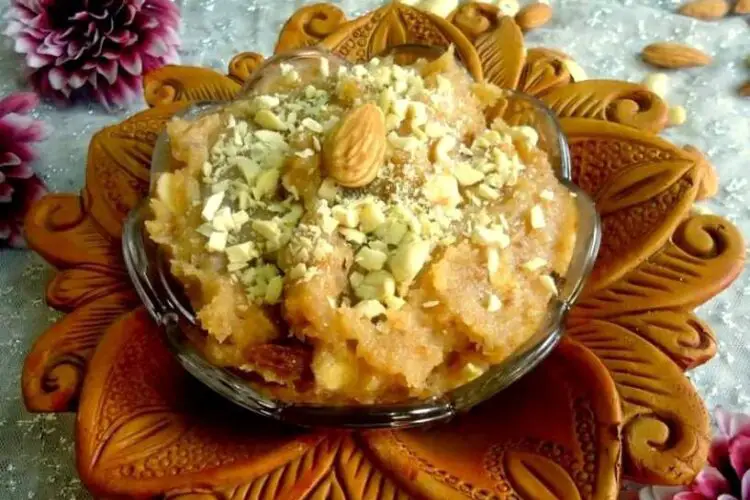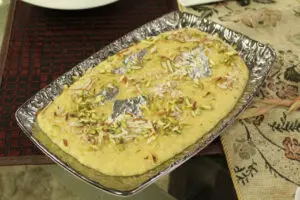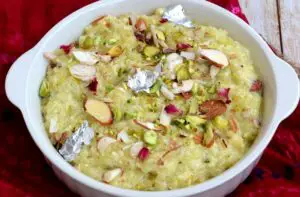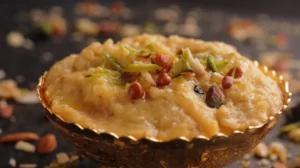Bread halwa is a delicious Indian dessert made from bread, sugar, ghee (clarified butter), and milk. It is a popular sweet dish and is often prepared during festivals or special occasions.
Here’s a simple recipe for bread halwa:
Ingredients:
- 6-8 slices of bread
- 1 cup milk
- 1 cup sugar
- 4 tablespoons ghee
- A handful of cashew nuts and raisins
- A pinch of cardamom powder
- Saffron strands (optional) for garnishing
Instructions:
- Remove the edges of the bread slices and cut them into small pieces or tear them into small crumbs.
- Heat ghee in a pan or kadhai (Indian wok) over medium heat.
- Add cashew nuts and raisins to the ghee and fry them until they turn golden brown. Remove them from the pan and keep them aside.
- In the same pan, add the bread pieces and roast them in ghee until they turn crisp and golden. Stir continuously to avoid burning.
- Once the bread pieces are roasted, add milk to the pan and mix well. Allow the bread to soak in the milk for a few minutes until it becomes soft and mushy.
- Add sugar to the mixture and stir well. The sugar will melt and combine with the bread and milk mixture.
- Cook the mixture on low heat for about 5-7 minutes, stirring continuously until it thickens and starts leaving the sides of the pan.
- Add cardamom powder and the fried cashew nuts and raisins. Mix well.
- Remove the pan from heat and transfer the bread halwa to a serving dish.
- Garnish with saffron strands and serve hot or warm.
Bread halwa is best enjoyed when served immediately. It has a rich and unique taste, combining the flavors of bread, sugar, and ghee. It can be served as a dessert after a meal or as a sweet treat during tea time. Enjoy!
Also, read more recipes:
About
Bread halwa is a sweet dish that is made by using bread as the main ingredient. The bread slices are typically torn or cut into small pieces and then roasted in ghee until they become crisp and golden. This step adds a delightful crunch and texture to the halwa.
Once the bread pieces are roasted, milk is added to the pan, and the bread is allowed to soak in the milk. This softens the bread and gives the halwa a moist and pudding-like consistency. The bread absorbs the flavors of the milk, creating a rich and creamy base for the halwa.
Sugar is added to the mixture to sweeten the halwa. The amount of sugar can be adjusted according to your taste preferences. As the mixture cooks, the sugar melts and combines with the bread and milk, infusing the halwa with its sweet taste.
To enhance the flavor, a pinch of cardamom powder is added. Cardamom adds a warm and aromatic touch to the halwa, enhancing its overall taste and aroma.
Cashew nuts and raisins are fried in ghee separately and then added to the halwa. These nuts and raisins provide a delightful crunch and sweetness to the dish, making it more indulgent.
Finally, the bread halwa is garnished with saffron strands. Saffron is an expensive and aromatic spice that adds a beautiful golden color and a subtle flavor to the dish.
Bread halwa can be served hot or warm as a dessert. It is a popular choice during festivals like Eid or Diwali, and it is also enjoyed as a sweet treat with tea or coffee.
Tips:
- Bread Selection: Choose fresh bread for the best results. White bread works well for this recipe, but you can also experiment with other types of bread like whole wheat or multigrain for a different flavor and texture.
- Roasting the Bread: When roasting the bread in ghee, make sure to keep the heat on medium to prevent burning. Stir the bread pieces continuously to ensure even browning. The bread should turn crisp and golden but not overly dark.
- Milk Quantity: The quantity of milk can vary depending on the type of bread used and personal preference. Add milk gradually, allowing the bread to soak and soften. If you prefer a more moist and gooey halwa, you can add a little extra milk.
- Sugar Adjustment: Adjust the amount of sugar according to your taste. If you prefer a sweeter halwa, you can increase the quantity of sugar. Similarly, if you like it less sweet, reduce the sugar amount. Remember to taste the mixture as you add sugar and adjust as needed.
- Cardamom Flavor: Cardamom powder adds a distinct flavor to the halwa. You can enhance the aroma by crushing the cardamom seeds and using freshly ground powder. Alternatively, you can use store-bought cardamom powder.
- Nut and Raisin Addition: Frying the cashew nuts and raisins separately in ghee adds a delightful crunch and sweetness to the halwa. Make sure not to over-fry them to avoid burning them. You can also add other nuts like almonds or pistachios for added variety.
- Saffron Garnish: Saffron strands are optional but add a beautiful color and subtle flavor to the halwa. Soak the saffron strands in a tablespoon of warm milk for a few minutes before garnishing. Then sprinkle them over the halwa for an attractive presentation.
- Serving Suggestions: Bread halwa tastes best when served hot or warm. You can enjoy it on its own as a dessert or pair it with a scoop of vanilla ice cream or a dollop of whipped cream for a luxurious treat. It also goes well with a cup of hot tea or coffee.
Serving Suggestions:
- Hot and Fresh: Bread halwa is best enjoyed when served hot or warm. Serve it immediately after preparing to experience the soft and gooey texture at its best.
- Garnish: Before serving, you can garnish the bread halwa with a sprinkle of chopped nuts like pistachios or almonds. This adds a nice crunch and visual appeal to the dish.
- Ice Cream Topping: For an indulgent twist, serve the bread halwa with a scoop of vanilla ice cream. The combination of warm halwa and cold ice cream creates a delightful contrast in flavors and temperatures.
- Whipped Cream: Another option is to serve the bread halwa with a dollop of lightly sweetened whipped cream. The creamy and airy texture of the whipped cream complements the dense and rich halwa.
- Chopped Fruits: For a refreshing touch, serve the bread halwa with a side of chopped fruits like bananas, mangoes, or berries. The fruity freshness balances the sweetness of the halwa and adds a burst of flavor.
- Drizzle of Rabri or Condensed Milk: To enhance the richness and sweetness, you can drizzle some thickened milk (Rabri) or condensed milk over the bread halwa. This adds a lusciousness to the dish and takes it to the next level.
- Tea or Coffee: Bread halwa pairs well with a cup of hot tea or coffee. The warm and comforting flavors of the beverage complement the sweetness of the halwa and make for a delightful combination.
FAQs
Q: Can I use stale bread to make bread halwa?
A: While fresh bread is generally preferred for bread halwa, you can use slightly stale bread as well. However, stale bread may take a bit longer to soften during the soaking process. You can also lightly toast the stale bread before using it to improve its texture.
Q: Can I use whole wheat bread or other types of bread for bread halwa?
A: Yes, you can use whole wheat bread or other types of bread for making bread halwa. Keep in mind that different types of bread will yield slightly different flavors and textures. Experimenting with different bread varieties can add interesting nuances to the final dish.
Q: Can I make bread halwa without milk or dairy?
A: Yes, you can make a dairy-free version of bread halwa. Instead of using milk, you can substitute it with almond milk, soy milk, or any other non-dairy milk of your choice. You can also use ghee alternatives like coconut oil or vegetable oil for frying the bread.
Q: How long does bread halwa stay fresh?
A: Bread halwa is best enjoyed when fresh and warm. It is recommended to consume it within a day or two of preparation. If you have leftovers, store them in an airtight container in the refrigerator. Before consuming, reheat it gently on the stovetop or in the microwave, adding a splash of milk if needed to restore moisture.
Q: Can I make bread halwa ahead of time?
A: While bread halwa is best enjoyed fresh, you can prepare it ahead of time and reheat it before serving. However, keep in mind that the texture may change slightly upon reheating, becoming a bit denser. It’s recommended to store the halwa and garnishes separately and combine them just before serving for the best results.
Q: Can I freeze bread halwa?
A: It is not recommended to freeze bread halwa, as freezing and thawing can affect its texture and flavor. The moisture content may change, resulting in a less desirable consistency. It’s best to consume bread halwa fresh or refrigerate it for a short period if needed.
Nutrition
Here is a rough estimate of the nutrition values for a typical serving (100 grams) of bread halwa:
- Calories: Approximately 300-350 calories
- Carbohydrates: Around 50-60 grams
- Fat: Approximately 10-15 grams, primarily from ghee and nuts
- Protein: Roughly 3-5 grams
- Sugar: Approximately 25-30 grams, primarily from added sugar
- Fiber: Typically low, around 1-2 grams
- Micronutrients: Bread halwa may provide small amounts of vitamins and minerals present in the ingredients used, such as calcium from milk and trace amounts of micronutrients from ghee, nuts, and spices.
You Might Also Like:
- A Paneer Chili recipe
- bread omelette recipe (cheesy)
- Veg Pulao recipe
- Bajra paratha recipe
- Bread Upma (Quick and Easy)





